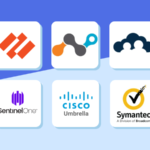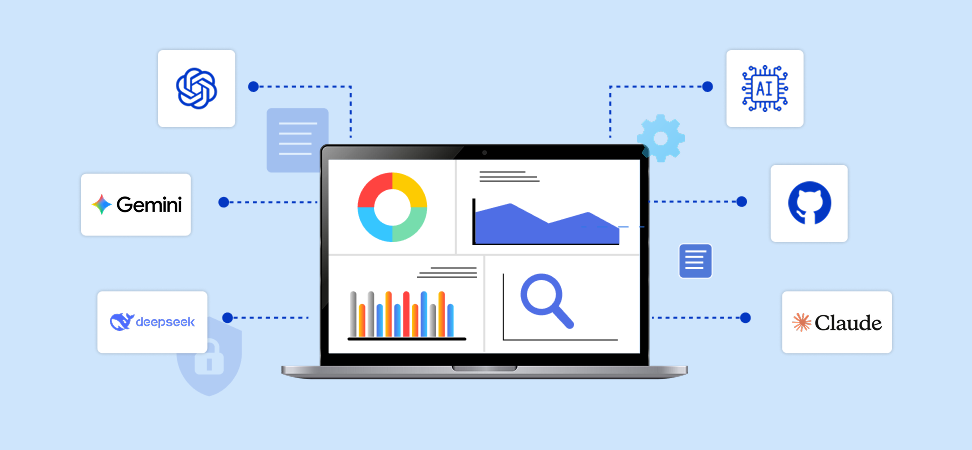Table Of Content
Earning Customer Trust in the Era of Gen AI and Agentic Workflows
-
August 18, 2025
-
Summary: Discover top SSE vendors & solutions in 2025, along with the list of features, competitors, and major differentiation (USP) of each vendor.
Generative AI is no longer a novelty—it’s foundational. In 2024, ChatGPT led the AI landscape with over 40 billion visits, 23 times more than its nearest competitor, Google’s Gemini. This surge reflects AI’s integration across all business functions:
- Engineering: AI-assisted coding and automated testing accelerate development cycles.
- Product Management: AI copilots refine roadmaps and optimize feature prioritization.
- Sales & Marketing: AI agents personalize campaigns, generate insights for customer & partner calls.
- Customer Support: AI enhances responsiveness without sacrificing human empathy.
However, with this rapid adoption comes a critical question: How can organizations preserve and grow customer trust when sensitive data is constantly moving across human-AI workflows?
The Trust–Productivity Paradox
AI thrives on rich, contextual data, but customer and partner information is not just another dataset. Mishandling it can have serious consequences:
- Regulatory scrutiny: Fines for GDPR, HIPAA, or PCI-DSS violations can exceed millions of dollars.
- Reputational damage: 83% of customers say they would stop doing business with a company following a data breach.
- Customer attrition: Loss of trust directly impacts retention, lifetime value, and brand loyalty.
A data-first strategy resolves this paradox: organizations can maximize AI-driven productivity while minimizing risk exposure, using structured processes to safeguard trust.
Strategies to Safeguard Trust
1. Map and Classify Data Flows
Identify where generative AI touches sensitive data. Classify data by sensitivity and context, ensuring AI tools only access appropriate information.
2. Establish Data Lineage
Track the origin, movement, transformation, and usage of data across AI workflows. Data lineage is critical because it:
- Ensures accountability for data handling.
- Helps quickly identify and remediate errors or misuse.
- Provides evidence for audits and regulatory compliance.
- Enhances trust by showing how customer and partner data is used throughout AI systems.
3. Transparency in AI Use
Treat AI tools and agentic workflows as data processors, and provide clear visibility into their operations:
- Third-Party Risk Assessment: Evaluate AI vendors for security, compliance, and privacy before adoption.
- Procurement Processes: Ensure contracts specify responsibilities for data handling, retention, and breach reporting.
- Data Visibility: Track who accesses data, where it is processed, when it is used, and what data is exposed.
- AI Governance Policies: Define acceptable use, sharing rules, and automated monitoring of AI interactions.
- Auditability: Maintain logs and reporting to demonstrate adherence to security and privacy policies.
- Trust & Accountability: Demonstrating clear controls signals to customers and partners that data is handled responsibly.
4. Policy-First AI Adoption
Define rules for what types of data can be ingested, shared, or restricted. Embed these policies into workflows before scaling AI tools.
5. Hyper-Converged Security Controls
Deploy platforms that automatically classify devices, users, and data. Granular controls allow organizations to enforce policies at scale: what’s permitted, blocked, or monitored.
6. Continuous Compliance Integration
Integrate compliance APIs with vendors like Vanta to automatically monitor AI workflows, ensuring they meet regulatory and industry standards in real-time.
7. Addressing Shadow Gen AI
Shadow Gen AI refers to the unsanctioned use of AI tools by employees, bypassing official channels. This poses significant risks:
- Data Leakage: Unauthorized tools may mishandle sensitive information.
- Compliance Violations: Unapproved tools may not adhere to regulatory standards.
- Security Breaches: Lack of oversight can lead to vulnerabilities.
To mitigate these risks:
- Implement AI Usage Policies: Clearly define acceptable AI tool usage within the organization.
- Monitor AI Tool Adoption: Use tools to track and manage AI tool usage across the organization.
- Coach Employees: Provide training on the risks associated with unauthorized AI tools and the importance of using approved platforms.
8. Data Sovereignty: Ensuring Control Over Data
Data Sovereignty refers to the concept that data is subject to the laws and governance structures within the nation where it is collected. In the context of Gen AI and agentic workflows, it is crucial to ensure that data remains under the jurisdiction of the organization’s home country to comply with local laws and regulations.
Top concerns organizations must address include:
Top concerns organizations must address include:
- Compliance with Local Regulations: Ensuring that data storage and processing comply with national laws, such as GDPR in the EU or CCPA in California.
- Cross-Border Data Transfers: Managing the complexities and risks associated with transferring data across borders, especially with varying data protection laws.
- Vendor Management: Assessing and managing the risks associated with third-party vendors, especially those located in jurisdictions with differing data protection standards.
- Data Localization: Implementing strategies to store and process data within specific geographic boundaries to meet regulatory requirements and reduce risks.
Measuring Trust as a KPI
Trust should be quantifiable. Metrics could include:
- Data access compliance rate: Percentage of AI interactions following internal data policies.
- Customer sentiment scores: Changes in trust perception before and after AI adoption.
- Incident response times: Speed at which data misuse or policy violations are remediated.
By embedding trust as a measurable KPI, organizations can demonstrate accountability while scaling AI initiatives.
Conclusion
AI and agentic workflows are rewriting productivity playbooks. Organizations that treat trust as a strategic asset — by integrating data lineage, transparency, policy-first adoption, hyper-converged security, continuous compliance, addressing shadow Gen AI, and ensuring data sovereignty — will gain a competitive advantage.
In the era of Gen AI, trust isn’t just a byproduct of security; it is a measurable, strategic differentiator that ensures sustainable growth and long-term customer confidence.
With over a decade of experience steering cybersecurity initiatives, my core competencies lie in network architecture and security, essential in today's digital landscape. At Kitecyber, our mission resonates with my quest to tackle first-order cybersecurity challenges. My commitment to innovation and excellence, coupled with a strategic mindset, empowers our team to safeguard our industry's future against emerging threats.
Since co-founding Kitecyber, my focus has been on assembling a team of adept security researchers to address critical vulnerabilities and enhance our network and user security measures. Utilizing my expertise in the Internet Protocol Suite (TCP/IP) and Cybersecurity, we've championed the development of robust solutions to strengthen cyber defenses and operations.
Posts: 35





